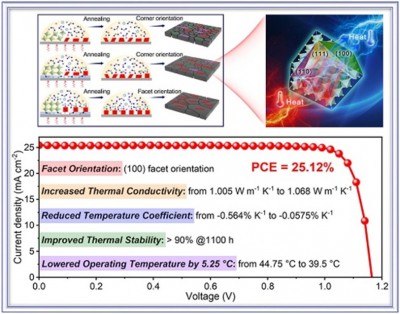Technology
Innovative Crystal Facet Engineering Boosts Solar Cell Efficiency

Recent advancements in solar technology have revealed a promising solution to the challenges posed by heat in perovskite solar cells (PSCs). A new study introduces a crystal facet engineering strategy aimed at enhancing the thermal stability and overall efficiency of PSCs. By optimizing the orientation of the perovskite film to the (100) facet, researchers have successfully improved heat transfer and reduced performance degradation at elevated temperatures.
The innovative approach results in inverted solar cells achieving an impressive efficiency of 25.12%. Importantly, these solar cells maintain over 90% of their initial performance even after prolonged exposure to light, demonstrating significant resilience under challenging conditions. This breakthrough could pave the way for more reliable solar energy technologies, suitable for long-term applications.
Enhancing Thermal Management in Solar Technology
Perovskite solar cells have gained recognition for their potential to deliver high power conversion efficiencies, often exceeding those of traditional silicon-based solar technologies. However, their sensitivity to heat has raised concerns about their long-term stability and practical usage in real-world environments. The research team focused on addressing this vulnerability through a novel technique that enhances thermal conductivity.
By directing the perovskite film towards the (100) facet, the study highlights a practical method for improving thermal management in solar cells. The modified cells demonstrated not only higher efficiencies but also a lower operating temperature, leading to a more stable power output. This is particularly significant as it enables the cells to perform effectively even when exposed to intense sunlight for extended periods.
The findings underscore the importance of facet orientation as a key factor in optimizing the performance of PSCs. Researchers believe that this approach could serve as a model for future developments in solar energy technology, emphasizing the need for effective thermal management solutions.
Potential Implications for Solar Energy Market
The implications of these findings are substantial, especially in the context of the ongoing global push for renewable energy sources. As the demand for sustainable energy solutions continues to rise, advancements in solar technology will play a critical role in meeting energy needs while minimizing environmental impact.
With the ability to maintain high efficiency and stability, these enhanced perovskite solar cells could become increasingly attractive to both consumers and manufacturers. The focus on thermal resilience may also lead to broader applications, including in regions with extreme weather conditions where conventional solar cells may struggle.
This research not only advances the field of solar energy but also contributes to the ongoing dialogue surrounding climate change and the transition to renewable energy sources. As countries around the world invest in green technologies, innovations like these could prove vital in achieving energy goals and reducing carbon footprints.
In conclusion, the introduction of crystal facet engineering in perovskite solar cells marks a significant step forward in solar technology, promoting greater efficiency and durability. With further research and development, these findings could help transform the solar energy landscape, making it a more viable option for the future.
-

 Technology5 months ago
Technology5 months agoDiscover the Top 10 Calorie Counting Apps of 2025
-

 Health2 months ago
Health2 months agoBella Hadid Shares Health Update After Treatment for Lyme Disease
-

 Health3 months ago
Health3 months agoErin Bates Shares Recovery Update Following Sepsis Complications
-

 Technology4 months ago
Technology4 months agoDiscover How to Reverse Image Search Using ChatGPT Effortlessly
-

 Technology1 month ago
Technology1 month agoDiscover 2025’s Top GPUs for Exceptional 4K Gaming Performance
-

 Technology2 months ago
Technology2 months agoElectric Moto Influencer Surronster Arrested in Tijuana
-

 Technology5 months ago
Technology5 months agoMeta Initiates $60B AI Data Center Expansion, Starting in Ohio
-

 Technology5 months ago
Technology5 months agoRecovering a Suspended TikTok Account: A Step-by-Step Guide
-

 Health4 months ago
Health4 months agoTested: Rab Firewall Mountain Jacket Survives Harsh Conditions
-

 Lifestyle5 months ago
Lifestyle5 months agoBelton Family Reunites After Daughter Survives Hill Country Floods
-

 Technology4 months ago
Technology4 months agoHarmonic Launches AI Chatbot App to Transform Mathematical Reasoning
-

 Technology3 months ago
Technology3 months agoUncovering the Top Five Most Challenging Motorcycles to Ride




















